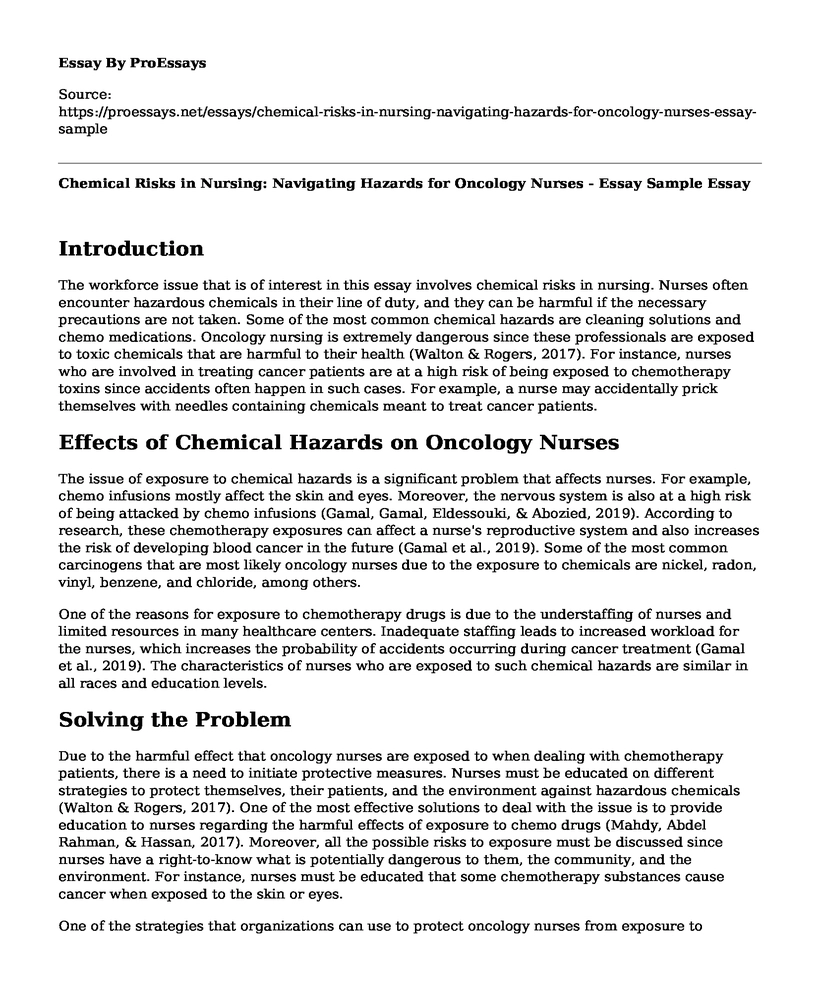Introduction
The workforce issue that is of interest in this essay involves chemical risks in nursing. Nurses often encounter hazardous chemicals in their line of duty, and they can be harmful if the necessary precautions are not taken. Some of the most common chemical hazards are cleaning solutions and chemo medications. Oncology nursing is extremely dangerous since these professionals are exposed to toxic chemicals that are harmful to their health (Walton & Rogers, 2017). For instance, nurses who are involved in treating cancer patients are at a high risk of being exposed to chemotherapy toxins since accidents often happen in such cases. For example, a nurse may accidentally prick themselves with needles containing chemicals meant to treat cancer patients.
Effects of Chemical Hazards on Oncology Nurses
The issue of exposure to chemical hazards is a significant problem that affects nurses. For example, chemo infusions mostly affect the skin and eyes. Moreover, the nervous system is also at a high risk of being attacked by chemo infusions (Gamal, Gamal, Eldessouki, & Abozied, 2019). According to research, these chemotherapy exposures can affect a nurse's reproductive system and also increases the risk of developing blood cancer in the future (Gamal et al., 2019). Some of the most common carcinogens that are most likely oncology nurses due to the exposure to chemicals are nickel, radon, vinyl, benzene, and chloride, among others.
One of the reasons for exposure to chemotherapy drugs is due to the understaffing of nurses and limited resources in many healthcare centers. Inadequate staffing leads to increased workload for the nurses, which increases the probability of accidents occurring during cancer treatment (Gamal et al., 2019). The characteristics of nurses who are exposed to such chemical hazards are similar in all races and education levels.
Solving the Problem
Due to the harmful effect that oncology nurses are exposed to when dealing with chemotherapy patients, there is a need to initiate protective measures. Nurses must be educated on different strategies to protect themselves, their patients, and the environment against hazardous chemicals (Walton & Rogers, 2017). One of the most effective solutions to deal with the issue is to provide education to nurses regarding the harmful effects of exposure to chemo drugs (Mahdy, Abdel Rahman, & Hassan, 2017). Moreover, all the possible risks to exposure must be discussed since nurses have a right-to-know what is potentially dangerous to them, the community, and the environment. For instance, nurses must be educated that some chemotherapy substances cause cancer when exposed to the skin or eyes.
One of the strategies that organizations can use to protect oncology nurses from exposure to hazardous chemicals is through the creation of a list indicating the drugs that are potentially harmful to the employees. The Occupational Safety and Health Administration requires that healthcare organizations must provide and continue updating a list of all the potentially harmful chemicals and substances that healthcare providers may be exposed to (Naresh, Bhat, Chavan, Bhat, & Vira, 2018). Conducting awareness is an effective step to ensure that healthcare providers are more careful during the handling of chemotherapy drugs. With such information, nurses would be cautious in the generation and disposal of hazardous chemicals in their line of duty.
Resources
Some of the incidents that lead to exposure to chemical hazards in nursing care are due to limited resources. Healthcare organizations must identify the resources that are required to promote the safety of its employees (Walton & Rogers, 2017). For instance, healthcare firms must have enough nurses to handle chemotherapy patients to avoid accidents due to cases of fatigue due to a sizeable nurse-patient ratio. Paying attention to the workload given to nurses is essential, and considering the excellent working conditions of oncology nurses is critical.
Healthcare organizations should also purchase essential and enough protective gear for nurses working with chemotherapy patients. All nurses must be provided with gowns, gloves, and other protective wear while dealing with chemo drugs (Walton & Rogers, 2017). The National Institute for Occupational Safety and Health demands that all nurses must be provided with the mandatory guidelines that they must follow to ensure that they are safe from exposure by hazardous chemicals. Organizations must also invest their time and money in education and training to teach about all the possible health risks and how to handle such issues (Naresh et al., 2018). For example, oncology nurses must be trained on how to prevent chemical exposures to their bodies and to the atmosphere as well.
References
Gamal, G. A., Gamal, L. M., Eldessouki, K. H. M., & Abozied, A. M. (2019). Chemotherapy Health Hazards among Oncology Nurses and its Possible Relation to Malpractice and Workplace Environment. Evidence-Based Nursing Research, 1(3), 10-10.
Mahdy, N. E., Abdel Rahman, A., & Hassan, H. A. (2017). Cytotoxic drugs safety guidelines: Its effect on awareness and safe handling practices of oncology nurses. J Nurs Hlth Sci, 6(3), 22-33.
Naresh, C., Bhat, V., Chavan, P., Bhat, P., & Vira, H. (2018). Staff Perceptions, Awareness and Compliance to Safety: A Survey of Occupational Hazards in a Cancer Centre. Journal of Oncology Translational Research, 4(1), 1-5.
Walton, A. L., & Rogers, B. (2017). Workplace hazards faced by nursing assistants in the United States: a focused literature review. International journal of environmental research and public health, 14(5), 544.
Cite this page
Chemical Risks in Nursing: Navigating Hazards for Oncology Nurses - Essay Sample. (2023, Mar 29). Retrieved from https://proessays.net/essays/chemical-risks-in-nursing-navigating-hazards-for-oncology-nurses-essay-sample
If you are the original author of this essay and no longer wish to have it published on the ProEssays website, please click below to request its removal:
- Term Paper Example on Public Health: Orem's Self-care Model for Patients with Diabetes
- American Express Campaigns
- Pathophysiology Diagnosis Paper Example
- Veterans Affairs (VA) Health System Paper Example
- Essay Example on Perineal Care: Prevent Burning, Odour & Itching Infections
- Essay Example on Vaccine Uncertainty: Healthcare Providers Must Address the Growing Concern
- Essay Example on Domestic Violence: Understanding the Cause to Provide Patient-Centered Care







